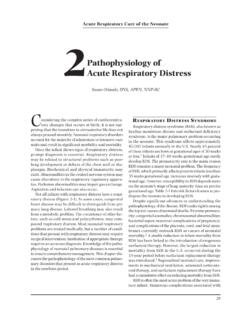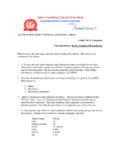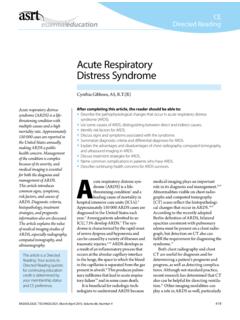Transcription of GUIDELINES ON THE MANAGEMENT OF ACUTE …
1 GUIDELINES ON THE MANAGEMENT OF ACUTE respiratory distress SYNDROMEV ersion 1 July 2018 2 CONTENTS Executive Summary 3 List of Contributors 4 List of Abbreviations 5 Introduction 7 Technical Summary 9 Corticosteroids 11 Extra Corporeal Membrane Oxygenation 14 Extra Corporeal Carbon Dioxide Removal 16 Fluid MANAGEMENT 19 High Frequency Oscillatory Ventilation 22 Inhaled Vasodilators 25 Mechanical Ventilation at Lower Tidal Volume 27 Neuromuscular Blocking Agents 31 Positive End Expiratory Pressure 34 Prone Positioning 37 Conclusion 41 MANAGEMENT of ARDS in Practice 44 References 47 3 EXECUTIVE SUMMARY The FICM/ICS Guideline Development Group have used GRADE methodology to make the following recommendations for the MANAGEMENT of adult patients with ACUTE respiratory distress syndrome (ARDS).
2 The British Thoracic Society supports the recommendations in this guideline. Where mechanical ventilation is required, the use of low tidal volumes ( < 6 ml/kg ideal body weight) and airway pressures (plateau pressure < 30 cmH2O) was recommended. For patients with moderate/severe ARDS (PF ratio < 20kPa), prone positioning was recommended for at least 12 hours per day. By contrast, high frequency oscillation is not recommended and it is suggested that inhaled nitric oxide is not used. The use of a conservative fluid MANAGEMENT strategy was suggested for all patients, whereas mechanical ventilation with high positive end-expiratory pressure (PEEP) and the use of the neuro-muscular blocking agent cisatracurium for 48 hours was suggested for ARDS patients with PF ratios less than or equal to 27 and 20 kPa respectively. Extra-corporeal membrane oxygenation (ECMO) was suggested as an adjunct to protective mechanical ventilation for patients with very severe ARDS.
3 In the absence of adequate evidence, research recommendations were made for the use of corticosteroids and extra-corporeal carbon dioxide removal (ECCOR). 4 LIST OF CONTRIBUTORS Guideline Development Group Professor Mark Griffiths Barts Health NHS Trust Dr Nicholas Barrett Guy s and St Thomas NHS Foundation Trust Professor Bronagh Blackwood Queen s University Belfast Dr Andrew Boyle Queen s University Belfast Dr Bronwen Connolly Guy s and St Thomas NHS Foundation Trust Professor Paul Dark The University of Manchester Dr Simon Finney Barts Health NHS Trust Professor Danny McAuley Queen s University Belfast Professor Gavin Perkins University of Warwick Dr Aemun Salam Barts Health NHS Trust Dr Jonathan Silversides Queen s University Belfast Dr Nicholas Tarmey Queen Alexandra Hospital, Portsmouth Dr Matt Wise University Hospital Wales, Cardiff Dr Simon Baudouin The Newcastle upon Tyne Hospitals NHS Foundation Trust Guideline Development Group Co-Chairs Professor Mark Griffiths Dr Simon Baudouin Guideline Development Group Patient Representatives Ms Julie Cahill Mr Gordon Sturmey Library Liaison Manager Ms Clare Crowley King s College London External Consultants Professor Ognjen Gajic Mayo Clinic, Rochester Professor B.
4 Taylor Thompson Massachusetts General Hospital/Harvard Medical School Associate Professor Eddy Fan Toronto General Hospital Guideline Development Group Co-ordinator Mrs Dawn Tillbrook-Evans FICM Co-ordinator 5 LIST OF ABBREVIATIONS AECC American European Consensus Conference AKI ACUTE Kidney Injury ARDS ACUTE respiratory distress syndrome BMI Body mass index CESAR Conventional ventilatory support vs extracorporeal membrane oxygenation for severe adult respiratory failure CI Confident interval cmH2O Centimetres of water EALI Early ACUTE lung injury ECCOR Extra-corporeal carbon dioxide removal ECMO Extra-corporeal membrane oxygenation ELSO Extra-corporeal Life Support Organization ESICM European Society of Intensive Care Medicine EVLW extravascular lung water FICM Faculty of Intensive Care Medicine FiO2 Fraction of inspired oxygen g/dl Grams per decilitre GDG Guideline Development Group HFOV High Frequency Oscillation HV/HTV Higher Tidal Volume I2 Meta analysis heterogeneity IBW Ideal body weight ICS Intensive Care Society ICU Intensive Care Unit iNO Inhaled nitric oxide iVasoD Inhaled Vasodilator kPa Kilopascal 6 LIPS Lung injury prediction score LIS Lung injury score LV/LTV Lower Tidal Volume MA Meta-analysis ml/kg Millilitres per kilogram mmHg Millimetres of mercury NICE The National Institute for Clinical Excellence NMBA Neuromuscular Blocking Agents p/f PaO2/FiO2 ratio PaO2 Partial pressure of oxygen in arterial blood PCWP Pulmonary capillary wedge pressure PEEP Positive end-expiratory pressure PETAL National Institutes of Health s Prevention and Early Treatment of ACUTE Lung Injury Network PICO Population, Intervention, Comparison, Outcome RCT Randomised clinical trials RR Relative risk RR respiratory rate (in Table 2.)
5 The Lung Injury Prediction Score only) RRT Renal Replacement Therapy SpO2 Oxygen saturation by pulse oximetry SR Systematic review VALI Ventilator associated lung injury Vt Tidal Volume vvECMO Veno-venous extra-corporeal membrane oxygenation 7 INTRODUCTION Aims The purpose of this guideline is to provide an evidence-based framework for the MANAGEMENT of adult patients with ACUTE respiratory distress syndrome (ARDS) that will inform both key decisions in the care of individual patients and broader policy. Our recommendations are neither dictates nor standards of care. We cannot take into account all of the features of individual patients and complex local factors; all we can do is to synthesise relevant evidence and to put it into the context of current critical care medicine. Similarly, our recommendations are not comprehensive: these GUIDELINES have relevance to a fraction of the total number of decisions that are required of carers for these complex patients.
6 Indeed, the current state of the art for the MANAGEMENT of ARDS has been recently reviewed1-4 and comparable GUIDELINES have been produced by national and international stakeholders5,6. Scope The topics considered were chosen by the Guideline Development Group (GDG) in the light of results from a survey carried out for the Intensive Care Society (ICS), including 556 responses from 3,200 members. Popular topics were excluded by the GDG if it was felt that there was a dearth of evidence ( appropriate investigations and the role of specialist centres), when the evidence was not specific to ARDS (weaning from mechanical ventilation, nutrition and the timing of tracheostomy) and if there was over-lap with existing GUIDELINES (post-ICU care and rehabilitation). Definitions ARDS was first reported in a case series from Denver in 19677. The American European Consensus Conference (AECC) 1994 defined ARDS as an ACUTE inflammatory syndrome manifesting as diffuse pulmonary oedema and respiratory failure that cannot be explained by, but may co-exist with, left-sided heart failure8.
7 In 2012, the AECC definition was re-evaluated and minor alterations were proposed by the European Society of Intensive Care Medicine (ESICM) ARDS Definition Task Force (Table 1). This iteration recognised 3 grades of severity depending on the degree of hypoxaemia and stipulated the application of at least 5 cmH2O of positive end-expiratory pressure (PEEP) or continuous positive airway pressure (CPAP). This so called Berlin definition was validated using retrospective cohorts and captures patients with a mortality of 24% in patients with mild ARDS, rising to 48% in the group of patients with the most severe respiratory failure9. A four-point lung injury scoring system (Murray Score or LIS) is the most widely used means of quantifying ARDS severity. It is based on the level of PEEP, the ratio of the partial pressure of arterial oxygen (PaO2) to the fraction of inspired oxygen (FiO2), the dynamic lung compliance and the degree of radiographic infiltration 7.
8 Although the LIS has been widely used in clinical studies and a score of > is commonly used as a qualifying threshold for support with extra-corporeal membrane oxygenation (ECMO), it cannot predict outcome during the first 24 to 72 hours of ARDS8. When the scoring system is used 4 to 7 days after the onset of the syndrome , scores of or higher predicted a complicated course requiring prolonged mechanical ventilation9. As a syndrome rather than a disease, there is no laboratory, imaging, or other gold standard diagnostic investigation for ARDS. Therefore like ACUTE kidney injury, ARDS is caused by a huge range of conditions and as a consequence patients with ARDS are heterogeneous. The outcome of these patients is determined by the underlying causes of ARDS, patient specific factors such as co-morbidities, clinical MANAGEMENT and the severity of illness. 8 Epidemiology and Outcomes Using the AECC definition, several population-based studies of ARDS showed a fairly consistent picture of the age, mortality, and severity of illness; however, there was almost a fourfold difference in incidence, probably contributed to by differences in study design and ICU utilisation10.
9 In the United States, there are estimated to be 190,000 cases and 74,000 deaths annually from ARDS11. Whereas in a third world setting, from 1046 patients admitted to a Rwandan referral hospital over 6 weeks, 4% (median age 37 years) met modified ARDS criteria. Only of patients with ARDS were admitted to an ICU, and hospital mortality was This study used the Kigali modification of the Berlin definition: without a requirement for PEEP, hypoxia threshold of SpO2/FiO2 less than or equal to 315, and bilateral opacities on lung ultrasound or chest radiograph 12. The recently published LUNG SAFE trial was designed to study prospectively the performance of the Berlin definition and to reflect modern MANAGEMENT of ARDS. To those ends, the investigators recorded admissions over 4 weeks to 459 ICU in 50 countries over 5 continents including 29,144 patients. In total, 3022 ( ) cases fulfilled ARDS criteria, including almost a quarter of those supported with invasive mechanical ventilation13.
10 Despite this relatively high prevalence and the study s focus on ARDS, the syndrome was recognised in only half of the mild ARDS group. Furthermore, in a study that reported on 815 patients with at least one risk factor for ARDS who were admitted to one of 3 Spanish hospitals over 4 months, 15 out of 53 patients (28%) were not admitted to an ICU suggesting that LUNG SAFE may have underestimated both ARDS incidence and over-looked Survivors commonly suffer from muscle weakness and neuropsychiatric problems, such that fewer than 50% have returned to work 12 months after leaving intensive care15. However, it is unusual for ARDS survivors to be significantly limited by chronic respiratory failure. Therefore ARDS is important both clinically and financially, because it is a not uncommon contributor to the deaths of critically ill patients of all ages and because survivors carry on suffering from the sequelae of critical illness long after they leave hospital 16.












